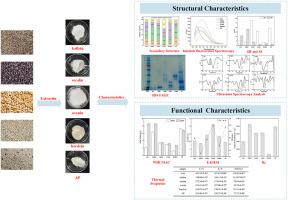Comparison of prolamins from different cereals based on structure and functionality
IF 3.9
2区 农林科学
Q2 FOOD SCIENCE & TECHNOLOGY
引用次数: 0
Abstract
In this study, the structure and functional properties of prolamins extracted from sorghum, rye, oat, barley and amaranth was systematic compared with commercial zein, e.g. secondary structure, electrophoresis profiles, sulfhydryl and disulfide content, surface hydrophobicity, emulsifying property and thermal stability. Kafirin and amaranth prolamin (AP) possessed much more ordered secondary structure. The conformation of hordein was more unfolded than other prolamins. Commercial zein possessed more tryptophan residues, while stronger polarity was observed in secalin, AP and avenin. As for the functionality, better emulsion activity and stability was found in avanin. Kafirin had the lowest denaturation temperature but highest enthalpy, which may be due to its lowest amount of β-turn and random coil. Stronger hydrophobicity was found with kafirin and AP, which was a positive correlation with oil holding capacity and emulsifying properties based on the principal component analysis. The findings provide some theoretical foundation in selecting desired prolamin to achieve more appropriate functional application.

根据结构和功能比较不同谷物中的丙种球蛋白
本研究系统地比较了从高粱、黑麦、燕麦、大麦和苋菜中提取的玉米蛋白与商品玉米蛋白的结构和功能特性,如二级结构、电泳图谱、巯基和二硫化物含量、表面疏水性、乳化性能和热稳定性。Kafirin 和苋菜蛋白(AP)的二级结构更为有序。蕨麻蛋白的构象比其他蛋白更不折叠。商品玉米蛋白具有更多的色氨酸残基,而雪卡林、AP 和鸦胆子蛋白则具有更强的极性。在功能性方面,avanin 具有更好的乳化活性和稳定性。Kafirin 的变性温度最低,但热焓最高,这可能是由于它的β-匝数和无规线圈最少。根据主成分分析,Kafirin 和 AP 具有更强的疏水性,这与持油能力和乳化特性呈正相关。这些发现为选择所需的丙烯胺以实现更合适的功能应用提供了一些理论依据。
本文章由计算机程序翻译,如有差异,请以英文原文为准。
求助全文
约1分钟内获得全文
求助全文
来源期刊

Journal of Cereal Science
工程技术-食品科技
CiteScore
7.80
自引率
2.60%
发文量
163
审稿时长
38 days
期刊介绍:
The Journal of Cereal Science was established in 1983 to provide an International forum for the publication of original research papers of high standing covering all aspects of cereal science related to the functional and nutritional quality of cereal grains (true cereals - members of the Poaceae family and starchy pseudocereals - members of the Amaranthaceae, Chenopodiaceae and Polygonaceae families) and their products, in relation to the cereals used. The journal also publishes concise and critical review articles appraising the status and future directions of specific areas of cereal science and short communications that present news of important advances in research. The journal aims at topicality and at providing comprehensive coverage of progress in the field.
 求助内容:
求助内容: 应助结果提醒方式:
应助结果提醒方式:


